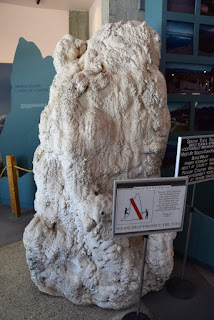We left Las Vegas and headed west to Death Valley. This is a
very hot moonscape.
In the middle of the valley
are sand dunes, 42°C with a hot dry wind blowing – really
inhospitable. The early settlers were a very hardy bunch. As for us - a quick
walk for a photo and then back into the car’s AC.
As it turned out our timing was particularly
good. 3 days later there was a 6.5 earthquake which caused quite a bit of
damage to buildings and roads. Over 80 further shakes were recorded over the
subsequent 24 hours.
A few hours later we
approached Mammoth Lakes where the temperature was a pleasant 18° and the snow contrasted with clear
blue skies and and rich green trees and verges.
The snow was still
sufficiently abundant to enable skiing – this on the 30th June!
An overnight stop and we
headed further West towards Yosemite. A lunch stop was required just before we
entered the park at Mono Lake. The lake has no outlet and over a year the
inflows from the Sierras evaporates. This makes for a turquoise and salty
lake.
A unique feature were growths
called Tufus. These form over many years as fresh water springs (with Calcium) bubble
through the alkaline water (Carbonates) to form Calcium Carbonate. It's rather like an underwater stalagmite.
As we climbed into Yosemite we
stopped by this wonderful lake before reaching Tolga pass (some 10,000 ft)
where we then had to drive in a no stop convoy across the park. This was due to
recent wet weather causing slips so the road was only open for a couple of
hours a day.
Yosemite is hugely popular,
particularly during the week of the 4th July. Accommodation was
scarce but we did get a tent cabin that we had hoped would be a bit of glamping
but…..There was also a 50 metre walk to the shared bathrooms.
Nonetheless the beds were
comfortable so a good nights sleep was possible. There was however a rule that any food or
smelly item was to be stored in our personal external bear proof safe. This did cause
some with an imagination to toss and turn following any unusual noise. It was a
stark comparison to our room in Vegas which was $20 per night cheaper!
Mind you they do manage to
accommodate an awful lot of people. It is a real tent city!
However, it was all worth it.
In contrast to the Grand Canyon, access is to the valley floor with towering
cliffs all around and several spectacular waterfalls. This is the Yosemite fall
which over its three sections falls some 740 metres and is the highest in USA
and 5th highest in the world. (The highest is Salto Angel in Venezuela
at 979m.)
I also managed to snap this
beautifully coloured Blue Jay.
Yosemite is also famous for
its giant Sequoia trees. This section was taken from one that died and showed
the tree to be 1100 years old. Its age is really brought to life by the
pointers. The second from the centre is the Battle of Hastings in 1066 followed
by the Magna Carta in 1215.
Having rather vegged in the
car over the previous days we decided a couple of walks were appropriate. The
first, up to the waterfall, was a pleasant couple of miles. After lunch we opted
for a bigger challenge and went to the Mirror Lakes and continued up to cross
the Tehaya river via a timber bridge. The last section up to the bridge was a
bit of a scramble along a creek bed. This had some worrying about how far
the bridge was, setting sun, bears etc…..
But we made it with plenty of
daylight to spare. On the way down was a rather novel rock garden. Balancing
rocks is becoming an intercontinental craze.
Our return (on the other side
of the river) underpinned why Mirror Lakes was so called with Mount Watkins
doubly splendid.
Opposite was Half Dome which
is visible from many areas of the park
On our way out of the park we
stopped at Tuolumne Grove where there are half a dozen Sequoias. It is very
difficult to capture their size, however at least this gives an indication of
their thickness compared to trees of a similar height.
There is also a dead one
which you can walk through whose age was well over 1000 years. Unfortunately, climate change with drier weather are putting the few that are left in jeopardy.
Although new ones have self set, at some 6 inches in 6 years they have many
human lifetimes to grow before they will equal the half dozen fully grown trees
that we were able to see.




















No comments:
Post a Comment